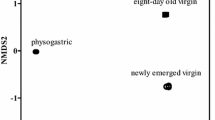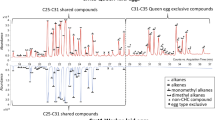Abstract
Queens of the slave-maker ant, Polyergus breviceps, take over nests of their Formica host species by fatally attacking the resident queen. As workers only begin grooming the P. breviceps queen once she has ceased her attack, we investigated whether a change in parasite queen chemistry may account for the change in worker behavior. Cuticular hydrocarbon profiles of newly mated P. breviceps queens and of queens of their two Formica host species were found to be species-specific. Profiles of newly mated P. breviceps queens that had attacked a Formica queen, however, were virtually identical to the queen profile of the species killed. Mass spectral analysis revealed that the hydrocarbons on the cuticles of newly mated P. breviceps changed from primarily normal alkanes to methyl and di-methyl branched alkanes after attacks. The results suggest that cuticular compounds from the host queen were transferred to the parasite queen during their aggressive interaction.
Similar content being viewed by others
REFERENCES
BAGNÈRES, A. G., LORENZI, M. C., DUSTICIER, G., TURILLAZZI, S., and CLÈMENT, J. C. 1996. Chemical usurpation of a nest by paper wasp parasites. Science 272:889–892.
BONAVITA-COUGOURDON, A., BAGNÈRES, A. G., PROVOST, E., DUSTICIER, G., and CLÈMENT, J. L. 1997. Plasticity of the cuticular hydrocarbon profile of the slave-making ant Polyergus rufescens depending on the social environment. Comp. Biochem. Physiol. B 116:287-302.
BONAVITA-COUGOURDON, A., CLÈMENT, J. L., and LANGE, C. 1987. Nestmate recognition: The role of cuticular hydrocarbons in the ant Camponotus vagus (Scop). J. Entomol. Sci. 22(1):1-10.
BONAVITA-COUGOURDAN, A., RIVIÈRE, G., PROVOST, E., BAGNÈRES, A. G., ROUX, M., DUSTICIER, G., and CLÈMENT, J. L. 1996. Selective adaptation of the cuticular hydrocarbon profiles of the slave-making ants Polyergus rufescens Latr. and their Formica rufibarbis Fab. and F. cunicularia Latr. slaves. Comp. Biochem. Physiol. B 113:313-329.
D'ETTORRE, P., ERRARD, C., IBARRA, F., FRANCKE, W., and HEFETZ, A. 2000. Sneak in or repel your enemy: Dufour's gland repellent as a strategy for successful usurpation in the slave-maker Polyergus rufescens. Chemoecology 10:135-142.
ERRARD, C. 1984. Evolution, en fonction de l'âge, des relations sociales dans les colonies mixtes heterospecifiques chez des fourmis des genres Camponotus et Pseudomyrmex. Insectes Soc. 31:185-194.
ERRARD, C., and D'ETTORRE, P. 1998. Camouflage chimique chez la reine de Polyergus rufescens lors de la fondation. Actes Coll. Insectes. Soc. 11:137-144.
FRANKS, N., BLUM, M., SMITH, R. K., and ALLIES, A. B. 1990. Behavior and chemical disguise of the cuckoo ant Leptothorax kutteri in relation to its host Leptothorax acervorum. J. Chem. Ecol. 16:1431-1444.
HABERSETZER, C. 1993. Cuticular spectra and inter-individual recognition in the slave-making ant Polyergus rufescens and the slave species Formica rufibarbis. Physio. Entomol. 18:167-175.
HABERSETZER, C., and BONAVITA-COUGOURDAN, A. 1993. Cuticular spectra in the slave-making ant Polyergus rufescens and the slave species Formica rufibarbis. Physio. Entomol. 18:160-166.
JACKSON, L., and BLOMOQUIST, G. 1976. Insect waxes, pp. 201-233, in P. E. Kolattuduy (ed.). Chemistry and Biochemistry of Natural Waxes. Elsevier, Amsterdam.
JAISSON, P. 1975a. Comment des formis apprennent àsoigner leur progèniture. Recherche 6:680-683.
JAISSON, P. 1975b. L'impregnation dans l'ontogenèse du comportement de soins aux cocons chez la jeune Fourmi rousse (Formica polyctena Först.). Behaviour 52:1-37.
JOHNSON, C. A. 2000. Mechanisms of dependent colony founding in the slave-maker ant, Polyergus breviceps Emery (Hymenoptera: Formicidae). PhD Dissertation. The Graduate School and University Center of the City University of New York, New York.
JOLLIFFE, T. 1986. Principal Component Analysis. Springer-Verlag, New York.
KAIB, M., HEINZE, J., and ORTIUS, D. 1993. Cuticular hydrocarbon profiles in the slave-making ant Harpagoxenus sublaevis and its hosts. Naturwissenschaften 80:281-285.
LAHAV, S., SOROKER, V., and HEFETZ, A. 1999. Direct behavioral evidence for hydrocarbons as ant recognition discriminators. Naturwissenschaften 86:246-249.
LE MOLI, F. 1980. On the origin of slaves in dulotic ant societies. Boll. Zool. 47:207-212.
LE MOLI, F., and MORI, A. 1982. Early learning and cocoon nursing behaviour in the red wood ant Formica lugubris Zett. (Hymenoptera: Formicidae). Boll. Zoo. 49:93-97.
LE MOLI, F., and MORI, A. 1987. Early social experience affects worker and cocoon discrimination in a slave ant species, p. 578, in J. Eder and H. Rembold (eds.). Chemistry and Biology of Social Insects. Verlag J. Peperny, München.
LE MOLI, F., and PASSETTI, M. 1977. The effect of early learning on recognition, acceptance and care of cooons in the ant Formia rufa L. Atti Soc. ital. Sci. nat. Museo civ. Stor. nat. Mil. 118:49-64.
LE MOLI, F., and PASSETTI, M. 1978. Olfactory learning phenomena and cocoon nursing behavior in the ant Formica rufa. Boll. Zoo. 45:389-397.
LENOIR, A., D'ETTORRE, P., ERRARD, C., and HEFETZ, A. 2001. Chemical ecology and social parasitism in ants. Ann. Rev. Entomol. 46:573-599.
LENOIR, A., FRESNEAU, D., ERRARD, C., and HEFETZ, A. 1999. Individuality and colonial identity in ants: The emergence of the social representation concept, pp. 219-237, in C. Detrain, J. L. Deneubourg, and J. M. Pasteels (eds.). Information Processing in Social Insects. BirkhauserVerlag, Basel.
MOREL, L. 1983. Relation entre comportement agressif et privation sociale prècoce chez les jeunes immatures de la Fourmi Camponotus vagus Scop. Comp. Ren. Acad. Sci. D, (Paris) 296:449-452.
MOREL, L., VANDER MEER, R. K., and LAVINE, B. K. 1988. Ontogeny of nestmate recognition cues in the red carpenter ant (Camponotus floridanus): Behavioral and chemical evidence for the role of age and social experience. Behav. Ecol. Socio. 22:175-183.
MORI, A., D'ETTORRE, P., and LE MOLI, F. 1995. Host nest usurpation and colony foundation in the European amazon ant, Polyergus rufescens Latr. (Hymenoptera: Formicidae). Insectes Soc. 42:279-286.
MORI, A., GRASSO, D., VISICCHIO, R., and LEMOLI, F. 2000a. Colony founding in Polyergus rufescens: The role of the Dufour's gland. Insectes Soc. 47:7-10.
MORI, A., VISICCHIO, R., SLEDGE, M. F., GRASSO, D. A., LE MOLI, F., TURILLAZZI, S., SPENCER, S., and JONES, G. R. 2000b. Behavioural assays testing the appeasement allomone of Polyergus rufescens queens during host-colony usurpation. Ethol. Ecol. Evol. 12:315-322.
NOWBAHARI, E., LENOIR, A., CLÈMENT, J. L., LANGE, C., BAGNÈRES, A. G., and JOULIE, C. 1990. Individual, geographical, and experimental variation of cuticular hydrocarbons of the ant Cataglyphis cursor (Hymenoptera: Formicidae): Their use in nest and subspecies recognition. Biochem. Syst. Ecol. 18:63-73.
OBIN, M. S. 1986. Nestmate recognition cues in laboratory and field colonies of Solenopsis invicta Buren (Hymenoptera: Formicidae). J. Chem. Ecol. 12:1965-1975.
SCHWAGER. S. J., and MARGOLIN, B. H. 1982. Detection of multivariate normal outliers. Annu. Stat. 10:943-953.
SOROKER, V., VIENNE, C., BILLEN, J., and HEFETZ, A. 1994. The postpharyngeal gland as a “Gestalt” organ for nestmate recognition in the ant Cataglyphis niger. Naturwissenschaften 81:510-513.
SOROKER, V., VIENNE, C., and HEFETZ, A. 1995. Hydrocarbon dynamics within and between nestmates in Cataglyphis niger (Hymenoptera: Formicidae). J. Chem. Ecol. 21:365-378.
TOPOFF, H., COVER, S., GREENBERG, L., GOODLOE, L., and SHERMAN, P. 1988. Colony founding by queens of the obligatory slave-making ant, Polyergus breviceps: The role of the Dufour's gland. Ethology 78:209-218.
TOPOFF, H., WEICKERT, T., and ZIMMERLI, E. 1990. A comparative study of colony takeover between queens of facultative and obligatory slave-making ants (Hymenoptera: Formicidae). J. Insect Behav. 3:813-817.
TOPOFF, H., and ZIMMERLI, E. 1993. Colony takeover by a socially parasitic ant, Polyergus breviceps: The role of chemicals obtained during host-queen killing. Anim. Behav. 46:479-486.
TURILLAZZI, S., CERVO, R., and CAVALLARI, I. 1990. Invasion of the nest of Polistes dominulus by the social parasite Sulcopolistes sulcifer (Hymenoptera, Vespidae). Ethology 84:47-59.
TURILLAZZI, S., SLEDGE, M. F., DANI, F. R., CERVO, R., MASSOLO, L., and FONDELLI, L. 2000. Social hackers: Integration in the host chemical recognition system by a paper wasp social parasite. Naturwissenschaften 87:172-176.
VANDER MEER, R. K., JOUVENAZ, D. P., and WOJCIK, D. P. 1989. Chemical mimicry in a parasitoid (Hymenoptera: Eucharitidae) of fire ants (Hymenoptera: Formicidae). J. Chem. Ecol. 15:2247-2261.
VANDER MEER, R. K., and MOREL, L. 1998. Nestmate recognition in ants, pp. 79-103, in R. K. Vander Meer, M. Breed, M. Winston, and K. E. Espelie (eds.). Pheromone Communication in Social Insects. Westview Press, Boulder.
VANDER MEER, R. K., and WOJCIK, D. P. 1982. Chemical mimicry in the myrmecophilous beetle Myrmecaphodius excavaticollis. Science 218:806-808.
VIENNE, C., SOROKER, V., and HEFETZ, A. 1995. Congruency of hydrocarbon patterns in heterospecific groups of ants: Transfer and/or biosynthesis? Insectes Soc. 42:267-277.
WAGNER, D., BROWN, M. F., BROUN, P., CUEVAS, W., MOSES, L. E., CHAO, D. L., and GORDON, D. M. 1998. Task-related differences in the cuticular hydrocarbon composition of harvester ants, Pogonomyrmex barbatus. J. Chem. Ecol. 24:2021-2037.
WHEELER, W. M. 1906. On the founding of colonies by queen ants, with special reference to the parasitic and slave-making species. Bull. Amer. Mus. Nat. Hist. 22:33-105.
YAMAOKA, R. 1990. Chemical approach to understanding interactions among organisms. Physio. Ecol. (Japan) 27:31-52.
ZAAYER, P. M. 1967. Paarung und koloniegründung von Polyergus rufescens Latr. im kunstnest (Hymenoptera: Formicidae). Zeit. Arbeits. öster. Entom. 19:1-9.
ZIMMERLI, E., and TOPOFF, H. 1994. Queens of the socially parasitic ant Polyergus do not kill queens of Formica that have not formed colonies (Hymenoptera: Formicidae). J. Insect Behav. 7:119-121.
Author information
Authors and Affiliations
Rights and permissions
About this article
Cite this article
Johnson, C.A., Vander Meer, R.K. & Lavine, B. Changes in the Cuticular Hydrocarbon Profile of the Slave-Maker Ant Queen, Polyergus breviceps Emery, After Killing a Formica Host Queen (Hymenoptera: Formicidae). J Chem Ecol 27, 1787–1804 (2001). https://doi.org/10.1023/A:1010456608626
Issue Date:
DOI: https://doi.org/10.1023/A:1010456608626




